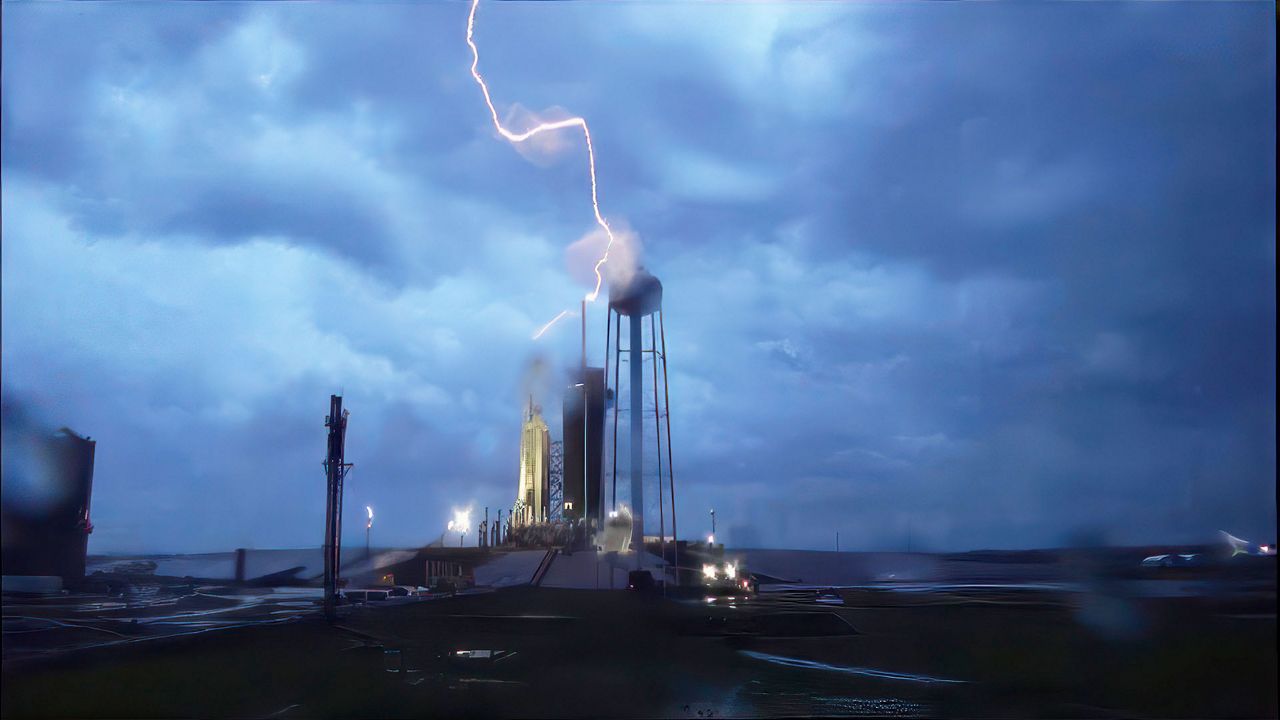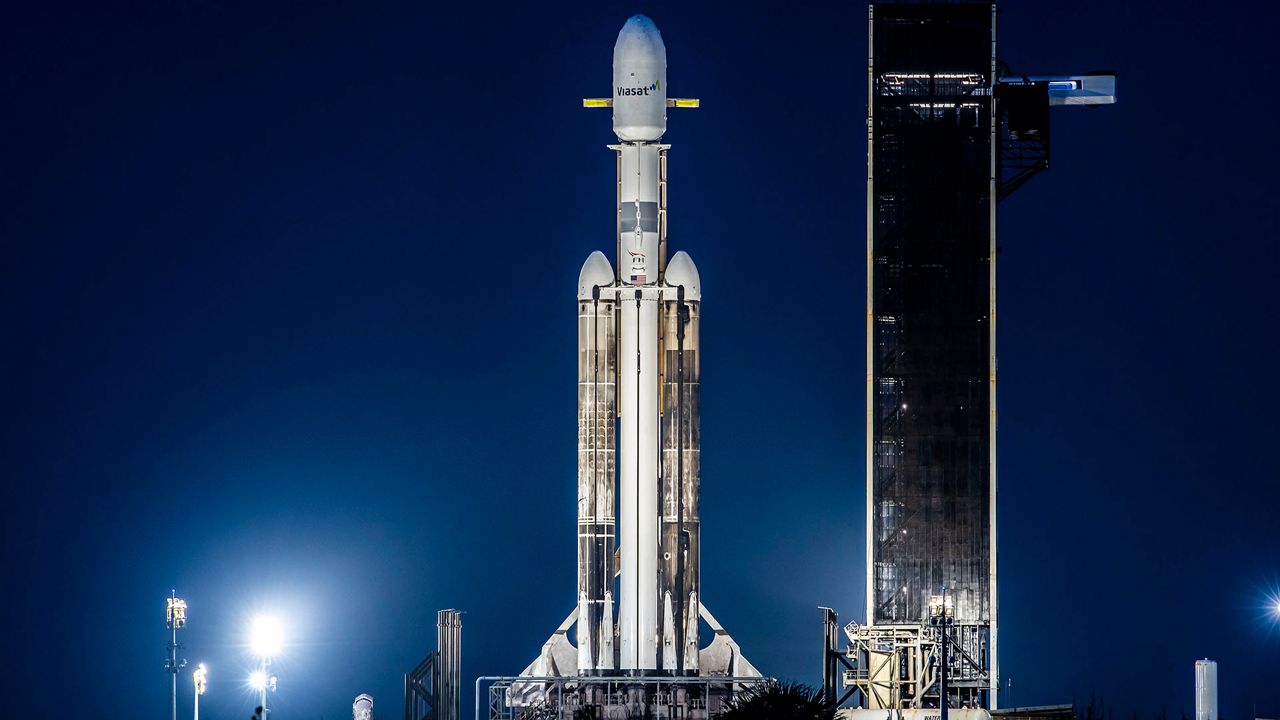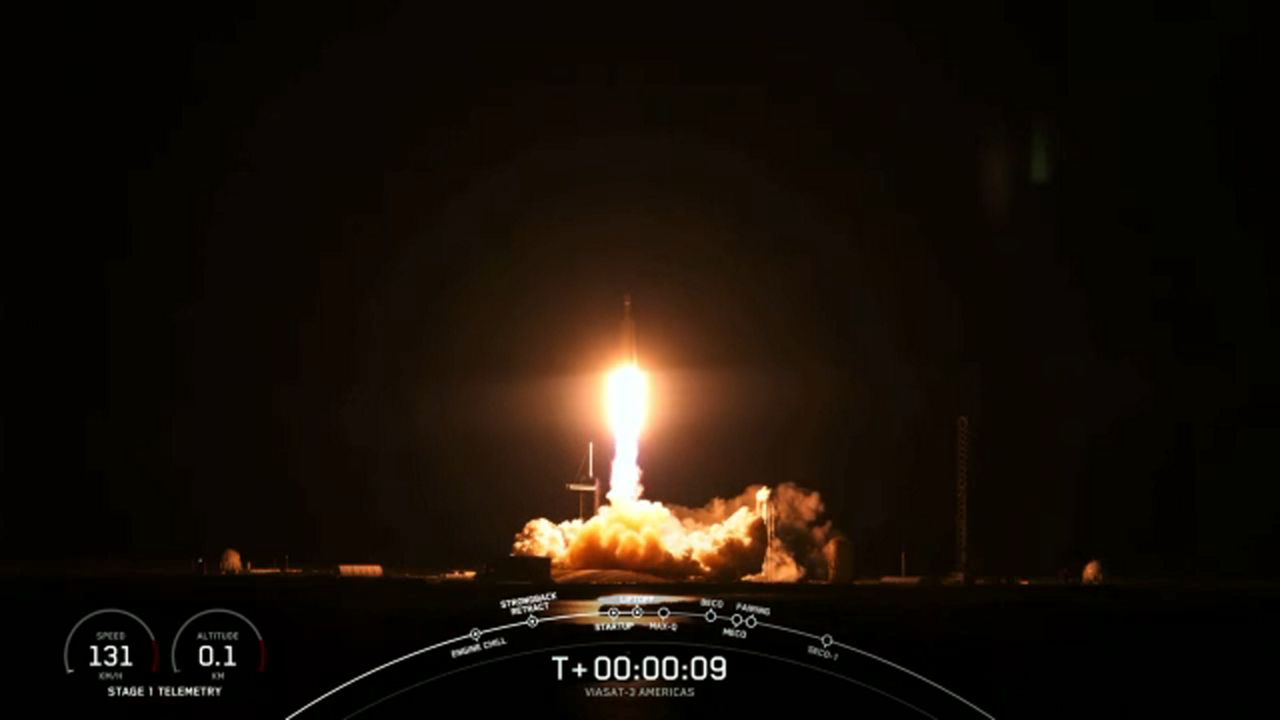KENNEDY SPACE CENTER — From weather delays and lightning striking the launch pad, SpaceX finally launched the Falcon Heavy rocket for the ViaSat-3 Americas mission on Sunday night.
What You Need To Know
- Officials say weather concerns prompted the company to push the launch several times
- ViaSat-3 Americas’, Astranis’ and Gravity Space’s satellites are onboard the Falcon Heavy
- 🔻Scroll down to watch the launch🔻
Liftoff! pic.twitter.com/EQMJRunDXH
— SpaceX (@SpaceX) May 1, 2023
About the launch
The Falcon Heavy rocket, which houses communication satellites from the ViaSat company and two other companies, took off from Launch Complex 39A at the Kennedy Space Center at 8:26 p.m. EDT.
SpaceX officials said the boosters for this mission have been around the block.
“One of the side boosters on this mission previously supported Arabsat-6A, STP-2, COSMO-SkyMed Second Generation FM2, KPLO, and three Starlink missions, and the second previously supported launch of Arabsat-6A and STP-2,” stated SpaceX.
SpaceX will not attempt to collect or land the boosters for this mission and will simply fall into the Atlantic Ocean. In fact, there will not be any landing legs on the first-stage boosters of the rocket.
A series of delays
Originally, the mission was scheduled to go up on Tuesday, April 18, but it was pushed back to Wednesday, April 26, then again on Thursday due to severe weather.
The next attempt was on Friday, but at T-59 seconds during the countdown of its Falcon Heavy launch for the ViaSat-3 Americas mission, SpaceX aborted the launch. No reason was given for the abort. During a live teleconference of the launch, a SpaceX official said that both the rocket and its payload are “healthy.”
The countdown clock stopped at T-59 seconds before the 8:26 p.m. EDT launch and then was reset to 15 minutes before SpaceX stated it was aborting the mission. SpaceX was hoping to try again on Saturday.
But then early Saturday, it determined that weather conditions were not favorable for a launch at that time either, and SpaceX stated it would try again Sunday.
Ground winds pushed Sunday’s launch from 7:29 p.m. EDT to 8:26 p.m. EDT.

Lightning strikes
SpaceX confirmed on Friday morning that the previous night's storms caused lightning to strike the tower of Launch Pad 39A at the Kennedy Space Center, where the company's Falcon Heavy rocket was stationed at.
All systems are looking good; weather conditions for tonight’s launch opportunity are currently ~30% favorable
— SpaceX (@SpaceX) April 28, 2023
While SpaceX has not confirmed when the lightning struck the tower, it appears to have happened about an hour after the company called off its Thursday night launch of three communication satellites from three different companies.
In a follow-up tweet, SpaceX stated that no damage was caused to the rocket or its launch systems, and that everything was looking good for the launch.
Like other launch pads, Launch Pad 39A (also known as Launch Complex 39A) has a lightning tower. This one is an 80-foot-tall fiberglass rod that is designed to protect the launch pad and vehicle from lightning strikes, explained NASA.
In August 2022, before the Artemis I launch, lightning struck Launch Pad 39B three times. At the time, the space agency stated lightning struck two of the three lightning protection system towers that are guarding Launch Pad 39B, which was the temporary home of the Artemis I mission.
Unlike Launch Pad 39A, Launch Pad 39B has three lightning towers, each one standing more than 600 feet tall.
While we were waiting for the @NASA #Artemis1 launch earlier today, Mark Burger of the #45thWeatherSquadron spoke to me about lightning strikes and protection towers. (See what happened on Saturday at #Artemis’ #LaunchPad39B.)https://t.co/K9EVrIgDHQ pic.twitter.com/XqyzowMgmq
— Anthony Leone (@AnthonyLeone) August 29, 2022

About the mission
Global communications company Viasat’s broadband communications satellite ViaSat-3 Americas will be sent to a geostationary orbit thanks to SpaceX’s Falcon Heavy rocket.
The satellite will provide internet and communication services to parts of North and South America, Europe, Africa, the Middle East and the Asia Pacific, stated the California-based company.
The first two ViaSat satellites lifted off in 2011 and 2017.
The 6-metric-ton ViaSat-3 Americas satellite is expected to deliver one terabit of data per second with anticipated download speeds of 100+ megabits per second.
In addition to the ViaSat-3 satellite, Astranis' first MicroGEO satellite and Gravity Space’s G-Space 1 satellite will also be onboard the Falcon Heavy.
Astranis, based in California, is sending its first MicroGEO communications satellite into a geostationary orbit.
The Washington state-based Gravity Space’s satellite will provide communication and internet services.
“We firmly believe that as we deploy all three of these satellites and have a truly global network, then you can use one system anywhere in the world. We think that’s going to be very attractive to a lot of our mobile markets, for example,” said Dave Ryan, the president of Space and Commercial Networks at Viasat.



